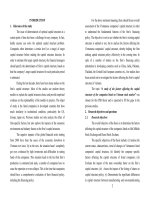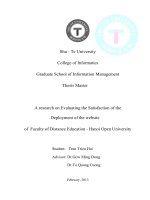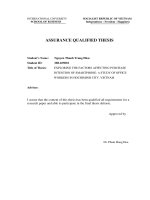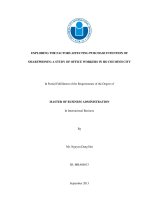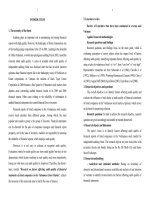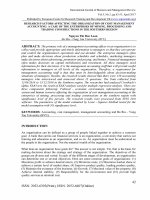A research on linguistic factors affecting the performances of the freshmen who are non-major english students on toeic listening test at IUH
Bạn đang xem bản rút gọn của tài liệu. Xem và tải ngay bản đầy đủ của tài liệu tại đây (1.96 MB, 68 trang )
MINISTRY OF INDUSTRY AND TRADE
INDUSTRIAL UNIVERSITY OF HO CHI MINH CITY
FACULTY OF FOREIGN LANGUAGES
------
GRADUATION THESIS
A
RESEARCH
ON
LINGUISTIC
FACTORS
AFFECTING THE PERFORMANCES OF THE
FRESHMEN WHO ARE NON-MAJOR ENGLISH
STUDENTS ON TOEIC LISTENING TEST AT IUH
STUDENT NAME
: NGUYỄN THỊ QUỲNH NHƯ
ID NUMBER
: 17032981
CLASS CODE
: DHAV13B
COHORT
: 2017-2021
SUPERVISOR NAME
: ĐINH THỊ HOA, M.A
HCMC, 06/2021
MINISTRY OF INDUSTRY AND TRADE
INDUSTRIAL UNIVERSITY OF HO CHI MINH CITY
FACULTY OF FOREIGN LANGUAGES
------
GRADUATION THESIS
A
RESEARCH
ON
LINGUISTIC
FACTORS
AFFECTING THE PERFORMANCES OF THE
FRESHMEN WHO ARE NON-MAJOR ENGLISH
STUDENTS ON TOEIC LISTENING TEST AT IUH
STUDENT NAME
: NGUYỄN THỊ QUỲNH NHƯ
ID NUMBER
: 17032981
CLASS CODE
: DHAV13B
COHORT
: 2017-2021
SUPERVISOR NAME
: ĐINH THỊ HOA, M.A
HCMC, 06/2021
Submitted by: Nguyễn Thị Quỳnh Như
ID number: 17032981
MINISTRY OF INDUSTRIAL AND TRADE
INDUSTRIAL UNIVERSITY OF HO CHI MINH CITY
FACULTY OF FOREIGN LANGUAGES
Student’s name: NGUYỄN THỊ QUỲNH NHƯ
Student’s ID: 17032981
Class: DHAV13B
Supervisor: ĐINH THỊ HOA, M.A.
Student’s declaration: I declare that this graduation report is entirely my own works and does not
involve in plagiarism or collusion. It also has not been accepted as part of a submission to another
purpose elsewhere. I accept heavy penalty for any cheating or plagiarism.
Date submitted: June 20th, 2021
Signed: ....................................................................................
Word length: 7284 words
Supervisor: Đinh Thị Hoa, M.A
Submitted by: Nguyễn Thị Quỳnh Như
ID number: 17032981
Title: A RESEARCH ON LINGUISTIC FACTORS AFFECTING THE
PERFORMANCES OF THE FRESHMEN WHO ARE NON-MAJOR ENGLISH
STUDENTS ON TOEIC LISTENING TEST AT IUH
Supervisor: Đinh Thị Hoa, M.A
Submitted by: Nguyễn Thị Quỳnh Như
ID number: 17032981
ABSTRACT
In the process of learning a foreign language in general, and the TOEIC learning test in particular,
listening ability, especially listening comprehension is plays an extremely important role . In
recent years, research into learning and teaching English listening skills has piqued Vietnamese
interest. However, there is still a lack of study on the key factors influencing the TOEIC listening
test of non-major English students at IUH. As a result, the aim of this research is to look into the
linguistic factors that influence the performance of the freshmen who are non-major in English at
IUH. Questionnaires are used as main instrument to collect data. Based on the findings, the
researcher proposes some recommendations for teachers and students to help students develop
listening skills and eventually improve TOEIC listening test scores as well as to help learners to
overcome their listening problems.
Keywords: Listening, Listening TOEIC test, Linguistic factors.
Supervisor: Đinh Thị Hoa, M.A
Submitted by: Nguyễn Thị Quỳnh Như
ID number: 17032981
ACKNOWLEDGEMENT
First of all, I would like to express thanks to the School Board of the Industrial University of Ho
Chi Minh City and the Faculty of Foreign Languages for generating chances me to know how to
work on the final proposal.
Secondly, I would like to express my endless thanks and gratefulness to my supervisor Mrs Dinh
Thi Hoa. Her kind-hearted support and continuous advice went through the process of completion
of my graduation report. Her encouragement and comments had significantly enriched and
improved my graduation report. The graduation report would have been impossible to complete
without her enthusiasm and instructions.
With deepest gratitude, allowing me to express my gratitude for their co-operation during the
time I collected data and information for my research.
Furthermore, I would like to thank my group members and especially are Tang Thi Kha Phuong
who often shared my feelings and gave me timely advice during the internship. And she is also
help me overcome all the difficulties to finish this internship report.
In short, I really thank to all people helping me to finish this graduation thesis. I would like to
express my heartfelt gratitude to the teacher's guidance, my colleagues, and my family for their
unwavering help and encouragement over the past four years as I prepared for life.
Supervisor: Đinh Thị Hoa, M.A
Submitted by: Nguyễn Thị Quỳnh Như
ID number: 17032981
TABLE OF CONTENTS
CHAPTER 1: INTRODUCTION .......................................................................... 1
1.1 Rationale .......................................................................................................... 2
1.2 Research Objectives ........................................................................................3
1.3 Research question ............................................................................................3
1.4 Scope of the study ...........................................................................................3
CHAPTER 2: LITERATURE REVIEW.............................................................. 4
2.1 Definitions of key term/concepts ..................................................................... 5
2.1.1. Listening ................................................................................................. 5
2.1.2. Listening comprehension ........................................................................ 5
2.1.3. Listening TOEIC test ............................................................................. 6
2.1.4. Linguistic factors ....................................................................................6
2.2 Results of previous studies............................................................................... 8
2.2.1 Listening Support in a Variety of Forms Reduces Listening Test
Anxiety ............................................................................................................. 8
2.1.2 A study of the major factors influencing the TOEIC listening test scores
of freshmen who are not majoring in English.................................................. 8
2.1.3 Factors affecting listening in L2 learning ............................................... 9
CHAPTER 3: RESEARCH DESIGN .................................................................. 11
3.1 Research site/context......................................................................................12
3.2 Participants/Objects....................................................................................... 12
3.3 Research methodology and research methods .............................................. 12
3.4 Procedures ..................................................................................................... 13
3.5 Data analysis ................................................................................................. 14
CHAPTER 4: FINDINGS AND DISCUSSION ..................................................15
Supervisor: Đinh Thị Hoa, M.A
Submitted by: Nguyễn Thị Quỳnh Như
ID number: 17032981
4.1 Findings......................................................................................................... 16
4.1.1 The current state of students' listening abilities ....................................16
4.1.2 How are IUH freshmen’s attitudes towards TOEIC listening test .......16
4.1.3 The linguistic factors affecting IUH freshmen’s performance on TOEIC
listening test ....................................................................................................20
4.1.4 Improve TOEIC listening results for IUH freshmen .............................23
4.2 Discussion .....................................................................................................28
4.2.1 How are IUH freshmen’s attitudes towards TOEIC listening test ...... 28
4.2.2 The linguistic factors affecting IUH freshmen’s performance on TOEIC
listening test ....................................................................................................28
4.2.3 How to improve Toeic listening result for IUH freshmen ....................28
4.3 Recommendations .........................................................................................29
CHAPTER 5: CONCLUSION .............................................................................30
5.1 Summary of the research ...............................................................................31
5.2 Solutions to solving the cause of IUH's first-year students' who are nonmajor English difficulty listening to listening skills ...........................................31
5.3 Limitation of the study ..................................................................................33
5.4 Further study ................................................................................................. 33
REFERENCES
APPENDENCIES
Supervisor: Đinh Thị Hoa, M.A
Submitted by: Nguyễn Thị Quỳnh Như
ID number: 17032981
TABLE OF FIGURES
Figure 4.1: The years that students have learned English........................................16
Figure 4.2: Student's opinion on the TOEIC............................................................17
Figure 4.3: Student's opinion about the TOEIC listening test ................................. 17
Figure 4.4: Students' emotions when taking the Toeic listening exam....................18
Figure 4.5: Students spend time practicing their listening skills on a daily basis ...19
Figure 4.6: The most boring and difficult part of the TOEIC listening test ............19
Figure 4.7: The factors that affected listening skills................................................21
Figure 4.8: Some activities students usually do to improve listening skills ............23
Figure 4.9: Student's opinion the importance of need to have the strategies for
listening test..............................................................................................................24
Figure 4.10: Some activities students usually do before doing the TOEIC listening
test ............................................................................................................................25
Figure 4.11: Activities students usually do while doing listening TOEIC test .......26
Figure 4.12: Student's opinion about activities students usually do when they can
not listen to the test...................................................................................................27
Supervisor: Đinh Thị Hoa, M.A
Submitted by: Nguyễn Thị Quỳnh Như
ID number: 17032981
CHAPTER 1: INTRODUCTION
Supervisor: Đinh Thị Hoa, M.A
Page 1
Submitted by: Nguyễn Thị Quỳnh Như
1.1
ID number: 17032981
Rationale
In today’s globalised economy, English is the universal language and it also has been widely
spoken language in the world, it is considered our primary source of communication as well as it
has long served as an international language of entertainment, science, business, information
technology, travelling and so on. Moreover, Being able to communicate in a foreign language not
only helps you find jobs, but it also help you to interact with people and learn more about
different cultures, locations, and lifestyles. The more professional you are, the more easily you
can express yourself. Therefore, English is the most important foreign language that is most
absolutely in the foreign language in Viet Nam. With all going on in our lives these days,
learning English is becoming easier. We can study using the Internet, which also allows us to
communicate with international friends and gather information. We can go for a walk in the park
and talk with other tourists.
Learning English is divided into several parts, each of which addresses a distinct need. Formerly,
the A, B, and C certificates were the most common in our country. However, the standards for
English certificates have become more stringent in recent years as society has grown and
international integration has increased. As a result, an increasing number of degrees exist to
determine a person's English proficiency, such as TOEFL, IELTS, and TOEIC. Depending on the
goals of each individual that choose different study programs. Nowadays, many universities in
Vietnam use English certificates to direct offer in the university such as Foreign Trade University,
University of Economics Ho Chi Minh City, Ho Chi Minh City University of Technology, Ho
Chi Minh University of Technology and Education,... unclock thousands of doors for students.
Thus, learning English becomes more and more important.
There are many factors get to learning English well, and language learners consider listening skill
to be the most important factor in determining whether or not they know a language and it seems
that the learner has had a lot of difficulty with this skill. Students have not discovered the causes
for their difficulties in learning listening skills, as well as they have not found out methods that
suitable for them. Recognize the importance of listening skills. Consequently, the study aims to
find out the factors affecting the performances of the freshmen who are non-major English
Supervisor: Đinh Thị Hoa, M.A
Page 2
Submitted by: Nguyễn Thị Quỳnh Như
ID number: 17032981
students on TOEIC listening test at IUH . and then based on the needs of the learners, make some
suggestions for learning English language programs are suitable for them.
1.2
Research Objectives
This study aims to find out linguistic factors affecting the performance of the freshmen who are
non-major English students on TOEIC listening tests at IUH. Based on the findings, the
researcher proposes some recommendations for students to help them improve their Toeic
listening test socres.
1.3
Research question
1.3.1. How are IUH freshmen’s attitudes towards TOEIC listening test ?
1.3.2. What are the linguistic factors affecting IUH freshman’s performance on listening TOEIC ?
1.3.3. What are solutions and methods to improve listening skills?
1.4
Scope of the study
The scope of study is major factors affecting the performances on TOEIC listening test of the
freshmen, the research occurred at Ho Chi Minh City's Industrial University. The main
participants are non- majored English freshman who are studying at faculties and institutes. The
research focused on non- majored English first-year because freshman must
be have base
English department and seem to they are facing with many difficulities in listeing skills,
especically the listening skills of the TOEIC test that measures English incoming inspection at
IUH. The researcher will invite participants from each of class to complete the survey
questionnaire and then know exactly situation that students have not understood or alarmed about
in listening skills. The researcher hopes that this study will help first-year students in improving
their listening skills while also assisting future studies in avoiding flaws and limitations. And
based on the survey, give out solutions and methods to help students improve in listening skills,
especially in TOEIC listening test
Supervisor: Đinh Thị Hoa, M.A
Page 3
Submitted by: Nguyễn Thị Quỳnh Như
ID number: 17032981
CHAPTER 2: LITERATURE REVIEW
Supervisor: Đinh Thị Hoa, M.A
Page 4
Submitted by: Nguyễn Thị Quỳnh Như
ID number: 17032981
2.1. Definitions of key term/concepts:
2.1.1. Listening:
According to Howatt and Dakin (1974) [1], simplified the definition of listening to “Listening
is the ability to identify and understand what others are saying. This process involves
understanding a speaker's accent or pronunciation, the speaker’s grammar and vocabulary,
and comprehension of meaning. ‘’An able listener is capable of doing these four things
simultaneously’’ (Abbas Pourhossein Gilakjani & Mohammad Reza Ahmadi, 2011) [2]
According to Conaway (1982) [3], listening is the most extensively employed language skill in
the classroom, and it has a greater impact on academic success than reading ability or academic
aptitude.
Thomlison (1984) [4] defines listening as, listening includes "active listening," which goes
beyond comprehending literally to an empathetic understanding of the speaker. And “Active
listening, which isvery important for effective communication”. Listening can be also defined
as, “More than just hearing and to understand and interpret the meaning of a conversation”. [5]
“Listening is the active process of receiving and responding to spoken (and sometimes
unspoken) messages,” according to Richard Nordquist (2019) [6]. It is a subject that is explored
in the field of language arts as well as in the discipline of conversation analysis. Listening
entails more than just hearing what the other person has to say in a conversation.”
2.1.2. Listening comprehension:
According Gary Buck (2001) [7] “Listening comprehension is a process, a very complex
process, and if we want to measure it, we must first understand how that process work, an
understanding of what we are trying to measure is the starting point for the test construction”.
Listening comprehension is described by Rost (2002) [8] and Hamouda (2013) [9] as an
interactive process in which listeners participate in the creation of meaning, Listeners
comprehend the oral input through sound discrimination, previous knowledge, grammatical
structures, stress and intonation, and the other linguistic or non-linguistic clues.
Supervisor: Đinh Thị Hoa, M.A
Page 5
Submitted by: Nguyễn Thị Quỳnh Như
ID number: 17032981
According to Nadif (2013) [10], the process of learning and making sense of spoken language
are referred to as listening comprehension.
2.1.3. Listening TOEIC test
According Kenneth M. Wilson (2014) [11] defined as: The TOEIC (Test of English for
International Communication) is a test used by non-native English speakers to assess their
listening and reading comprehension skills in English. There are seven different kinds of test
items used in this test (four for assessing listening comprehension and three for assessing
reading comprehension).
The Ministry of Education and the Education Testing Institute in the United States considered
the use of TOEIC to assess students' English language proficiency in 2005. As a result, instead
of using the old program and testing for A, B, and C certificates, universities in Vietnam will
use the TOEIC program to educate and assess students' learning outcomes.
Listening comprehension and reading comprehension are the two parts of the test. On a scale of
10 to 990, the TOEIC test is graded. Your score is based solely on correct responses. These
correct answers are added together and converted into a TOEIC score. [12]
2.1.4 Linguistic factors:
Vocabulary
“Vocabulary is one of five core components of reading instruction that are essential to
successfully teach children how to read. These core components include phonemic awareness,
phonics and word study, fluency, vocabulary, and comprehension” (National Reading Panel,
2000) [13] . “Vocabulary is the glue that holds stories, ideas and content together…” (Rupley,
Logan & Nichols, 1998/99) [14]
According to Hilde van Zeeland (2018) [15] said that "Learners' vocabulary knowledge can serve
as a predictor of their listening success and discusses how much word knowledge is required for
adequate listening comprehension. It also explains how to assess whether learners' vocabulary
knowledge is sufficient for them to comprehend particular passages”
Supervisor: Đinh Thị Hoa, M.A
Page 6
Submitted by: Nguyễn Thị Quỳnh Như
ID number: 17032981
Synonym
Novikov (1968) [16] “ was the first who made the attempt to classify synonyms. He in his paper
wrote about the complete interchangeableness and partial interchangeableness, as well as the
existence of perfect and partial synonyms”.
The Romanian linguist Bulgar (2000) [17] said that “synonyms are those words which have
almost the same meaning and they can be used interchangeably context-wise and they don’t
change the meaning of the context”.
Pronunciation
According to Larry M. Lynch [18] said that “Everyone speaks in a specific way and employs
numerous types of linked voice. On an individual basis, factors such as elision, contraction,
juncture, liaison, register, accommodation, aspect, intonation, and others influence
pronunciation and speech patterns. Listening comprehension can be greatly impacted when
learners are unfamiliar with, or even unaware of, these elements”.
Regional or National Accents
Larry M. Lynch said that “The same sentence may be substantially different when spoken by
people of different first language (L1) backgrounds, geographic places, or ethnic backgrounds.
Lack of familiarity on the part of EFL learners can result in a definite lack of listening
comprehension or "comprehensible input”.
According to Ur (1984), "many foreign-language learners who are used to their own teachers'
accents are shocked and dismayed when they find themselves unable to understand anyone else."
In reality, students may come across a variety of accents while listening. When it comes to
English, Australians pronounces English differently from American, and this is different again
from British English (Buck, 2001)
Language Rhythms
Supervisor: Đinh Thị Hoa, M.A
Page 7
Submitted by: Nguyễn Thị Quỳnh Như
ID number: 17032981
According to Richard Nordquist (2019) defines that “ In phonetics, rhythm refers to the sense of
movement in speech, which is described by syllable stress, timing, and quantity. The recurring
alternation of strong and weak elements in the flow of sound and silence in sentences or lines of
verse is known as rhythm in poetry ” [19]
One of the main distinctions between English and, say, Spanish is that one is based on syllables
while the other is based on accents. This explains why non-native speakers who speak a language
other than their mother tongue sound "funny."
2.2 Results of previous studies:
Previous research on learners' listening skills revealed the factors that influence their ability to
listen. Furthermore, some authors provided techniques and listening strategies that aid learners in
improving and enhancing their listening abilities. Furthermore, some authors have looked into the
techniques used by teachers to teach listening skills, as well as what happens when students listen.
Each author discussed various aspects of listening skills, as well as techniques and strategies. As
a result, it builds diversity and richness between the authors' various viewpoints on a research
subject.
2.2.1 Listening Support in a Variety of Forms Reduces Listening Test Anxiety.
According to Anna Ching-Shyang Chang & John Read (2008) [20]. This authors are find out the
four types of listening support (content and vocabulary pre-teaching, question preview, and
repeated input) influence the anxiety levels of Taiwanese college students taking a multiplechoice achievement test. The research included 160 business majors who were enrolled in an
English listening course at a Taiwanese university. They had spent an average of seven years in
school learning English as a foreign language and had little opportunities to practice it outside of
class. The reasearcher uesed a questionnaire includes 33 Likert-type items with the standard fivepoint response scale from "strongly agree" to "strongly disagree".
2.1.2 A study of the major factors influencing the TOEIC listening test scores of
freshmen who are not majoring in English.
Supervisor: Đinh Thị Hoa, M.A
Page 8
Submitted by: Nguyễn Thị Quỳnh Như
ID number: 17032981
According to Nguyen Thi Huyen Trang (2012) [21] also gave out two main factors: Linguistic
and non-linguistic based on the theories collected from many differenr source. Linguistic factor
included the sound and pronunciation, the stress and intonation, speech, syntax and vocabulary,
informal language , and accent while Non-linguistic factors considerd of fatigue, listener’s
background, listener’s competence, message and physical setting. The research used both
quantitative and qualitative approaches with the triangulation of questionnaire, observations, and
semi-structured interviews were utilized in the study. Based on the findings, the reasearcher
claims that students had more difficulty with TOEIC listening due to linguistic factors than nonlinguistic factors, according to the results. The first barrier was "speakers' pronunciation," which
most students thought was the reason they couldn't understand them. Another issue that prevented
students from effectively listening to the TOEIC test was "new vocabularies and structures." In
addition, students were anxious and tense while listening because they couldn't keep up with the
fast sound that was playing constantly, which had an effect on comprehension." Buck, 2001)
The study also exist a number of limitations are: First and foremost, the small number of
participants (only 54) did not adequately reflect the entire Vimaru freshman class. And beside
that, the students may come from a range of backgrounds and levels, as well as have faced with
different difficulty with TOEIC listening, so that the general conclusion's reliability and validity
may be impacted.
2.1.3 Factors affecting listening in L2 learning
According to Tatiana Rasskazova, Natalia Glukhanyuk (2018) [22]. The aim of this research is to
summarize and present research on factors that influence listening comprehension in second
language learners. The authors also gave out some factors affecting listening in learning. It is
Phonological factors, Linguistic factors, Cognitive factors, Sociopsychological factors, and other
factors. Cognitive factors constitute the largest group of factor. The study was based on a list of
about 50 published papers in this area; the emphasis was primarily on linguistics, sociolinguistics,
language teaching and learning, and psycholinguistics. This article is critical for understanding
where the field of research is at the moment, particularly in studies of adult L2 learners who are
struggling with listening as a critical skill for success.
Supervisor: Đinh Thị Hoa, M.A
Page 9
Submitted by: Nguyễn Thị Quỳnh Như
ID number: 17032981
To summarize, all of above studies were chosen because the writers were interested in developing
listening skills through various approaches, techniques, or tools , just as the researcher was with
the current research. The authors previously listed have used a variety of methods to better
understand the learning process of students and to assist them in overcoming some of the
challenges that they through face in this area. As a result, the researcher chose these studies to
help her study investigation because the researcher was curious about the factors that influence
listening skills and wanted to include methods that were suitable for each learner level.
Furthermore, to learn more about how listening skills can be applied to other skills.
Supervisor: Đinh Thị Hoa, M.A
Page 10
Submitted by: Nguyễn Thị Quỳnh Như
ID number: 17032981
CHPATER 3: RESEARCH DESIGN
Supervisor: Đinh Thị Hoa, M.A
Page 11
Submitted by: Nguyễn Thị Quỳnh Như
ID number: 17032981
3.1. Research site/context:
The research took place at Industrial University of Ho Chi Minh City where the researcher have
studied. Industrial University of Ho Chi Minh city is located in 12 Nguyen Van Bao Street, Ward
4, Go Vap District, Ho Chi Minh City. It is one of Vietnam's largest educational institutions, with
fully equipped, particularly ideal theoretical rooms or lecture rooms with projectors, large screens,
and loudspeakers for thousands of students. The school also has a canteen, dormitory, library, and
multi-purpose gym. All students have access to an Internet system, which makes it easier for
them to search for information.
All of the survey participants were freshmen without an English major who studying in faculties
and institutes. Students at the University of Industry in Ho Chi Minh City (IUH) come from all
over the country and they were in the second semester of their academic year 2020-2021 at
school.
3.2. Participants/Objects:
The study was undertaken of 100 non-English majors freshmen who studying at the Industrial
University of Ho Chi Minh City's faculties and institutes. They were chosen at random for the
study when they were in the second semester of their academic year 2020-2021 at school. They
were taking based -English class. Their age are 19 years old. They come from many different
departments and levels, and their attitudes and preferences toward listening skills in general, and
listening TOEIC in particular, are diverse. Many of them have similar English backgrounds
because they were influenced by English curriculum for high school students in the past, and
students did not have many opportunities to practice English skills, particularly listening skills.
Because most high school English teachers focus solely on grammar, students appear to be many
struggling with their listening skills. Through this research, can find out solutions and methods to
help them improve their English as well as find excited about learning English.
3.3. Research methodology and research methods:
Supervisor: Đinh Thị Hoa, M.A
Page 12
Submitted by: Nguyễn Thị Quỳnh Như
ID number: 17032981
In the process of investigating on major factors affecting the performances of the freshmen who
are non-major English students on TOEIC listening test , researchers chose two approaches
categorized such as research and questionnaires.
3.3.1. Research methodology
Pritha Bhandari (2020) [23] defines quantitative approach as follows: Quantitative research is the
process of collecting and analyzing numerical data. It can be used to look for trends and averages,
make predictions, test causal relationships, and extrapolate findings to larger groups.
Quantitative research is a method for collecting data that is based on inductive reasoning. From
an insider's viewpoint, the issue. In addition to assisting in the rapid discovery of useful
information, quantitative research is often faster and less expensive than qualitative research.
3.3.2. Research methods
The research will be conducted using questionnaire included closed-ended questionnaires and
opened-ended questionnaires.
According Saul McLeod (2018) [24] defines as “A questionnaire is a research tool that consists
of a series of questions designed to collect data from respondents. Questionnaires are similar to
written interviews in that they collect information. They can be done in person, over the phone,
on the web, or by mail ”. Quantitative research is often faster and less costly than qualitative
research, in addition to helping in the rapid discovery of useful information.
Questionnaires can be a cost-effective and fast way to assess the behavior, attitudes, preferences,
views, and intentions of a large number of people. Furthermore, the use of closed-ended and
open-ended questionnaires is beneficial. Respondents to closed-ended questionnaires are simple
and quick to respond to. There will be almost no difficult-to-understand responses. Furthermore,
using open-ended questionnaires allows you to gain a better understanding of the subject under
discussion. Respondents may feel that they are receiving personal attention and that the
proponent is interested in their opinion.
3.4. Procedures:
Supervisor: Đinh Thị Hoa, M.A
Page 13
Submitted by: Nguyễn Thị Quỳnh Như
ID number: 17032981
Firstly, the researcher began to design a form of questionnaire (estimated 100 participants). Form
of questionnaire included 15 closed-ended questionnaire and 1 open-ended questionnaire based
on three research questions and a content of the thesis under the supervisor's instructions.
Secondly, the researcher sent a letter asking for permission from the Board of Faculty of Foreign
Language and the supervisor who was allowed to investigate online students on Facebook groups
from April 10th to 30th. Those students took the Toeic listening test before. This questionnaire
was posted in several groups on Facebook page where the freshmen were participated it. When
the researcher posted on Facebook, the researcher introduced name of group members and the
purpose of this study (if participants deal with difficult in this questionnaire, the researcher would
explain it). The participant would complete the student’s personal information such as: Gmail,
Gender, and Major.
Finally, the researcher did not forget to thank the respondents sincerely through Gmail after they
complete the online survey. Then, the researcher gathered all of the data and analyzed the results.
3.5 Data analysis:
Researcher have used Scholar Google databases for the search definition of keywords: listening,
listening comprehension, listening TOEIC test, linguistic factor.
The questionnaire data were classified into different categories such as Google, Excel tool. The
questionnaire data were classified into different categories such as Google, Excel tool. The data
were analyzed quantitatively by means of descriptive statistics. When the data collection was
accomplished, the data analysis was initiated. Microsoft Excel was used in data analysis. “Excel a
software program created by Microsoft that uses spreadsheets to organize numbers and data
with formulas and functions. Excel analysis is ubiquitous around the world and used by
businesses of all sizes to perform financial analysis’’ [25] . The data are analyzed in this part of
the study in the pie, column and table chart which show the responses for questions in the
questionnaires.
Supervisor: Đinh Thị Hoa, M.A
Page 14
Submitted by: Nguyễn Thị Quỳnh Như
ID number: 17032981
CHAPTER 4: FINDINGS AND DISCUSSION
Supervisor: Đinh Thị Hoa, M.A
Page 15
Submitted by: Nguyễn Thị Quỳnh Như
4.1
ID number: 17032981
Findings:
This data analysis was done in response to three research questions about linguistic factors
affecting the performances of the freshmen who are non-major English students on TOEIC
listening test at IUH. And the possible difficulties students can face, as well as the effect these
factors have on their communicative abilities.
4.1.1 The current state of students' listening abilities:
The study focused on freshman students who are non major English students at
Industrial University of Ho Chi Minh City. The important thing was the previous they
usually concentrate on grammar. They seemed no concentrate on other skills as
listening or speaking.
T
The number of years that a student
has spent studying English
5%
15%
6%
More than 3 years
More than 5 years
More than 7 years
74%
Other
FIGURE 4.1: THE YEARS THAT STUDENTS HAVE LEARNED ENGLISH
The graph depicted how long students had been learning English. According to the pie map, the
majority of students have studied English for more than seven years, accounting for 74 percent of
the total. 15 percent students gave another answer and beside that, the reasercher have 6% studied
English five years and 5% studied three years.
4.1.2 How are IUH freshmen’s attitudes towards TOEIC listening test
Supervisor: Đinh Thị Hoa, M.A
Page 16

